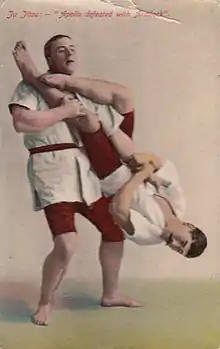Yukio Tani
Yukio Tani (谷 幸雄, Tani Yukio, 1881 – 24 January 1950) was a pioneering Japanese jujutsu and judo instructor and professional challenge wrestler, notable for being one of the first jujutsu stylists to teach and compete outside of Japan.

Biography
The precise details of Tani's early jujutsu training in Japan are unclear, but he is known to have studied at the Fusen-ryu dojo, as Yukio's father and grandfather were friends with Fusen-ryu master Mataemon Tanabe. He also trained in Yataro Handa's jujutsu school in Osaka.[1] In 1900, the nineteen-year old Yukio, his brother Kaneo and a fellow jujutsuka Seizo Yamamoto travelled to London by invitation of Edward William Barton-Wright, the founder of Bartitsu.[2] His brother and Yamamoto soon returned to Japan, but Yukio stayed in London and began appearing at music halls, giving demonstrations of jujutsu and placing challenges to all comers. Tani and Uyenishi were also employed as jujutsu instructors at Barton Wright's "Bartitsu School of Arms and Physical Culture" at 67b Shaftesbury Avenue in London's Soho district.
After breaking with Barton-Wright in 1903, Tani joined forces with veteran show business promoter William Bankier, who had himself been a music hall performer under the name "Apollo, the Scottish Hercules" and had met Yukio in his tenure with Barton. Under Bankier's management, Tani became a professional wrestler on the music hall circuit, where he would challenge anyone willing to test his skill. With the temptation of winning £1 for lasting each minute, for a bout of up to 5 minutes, or £5 to £100 for winning, there was never a shortage of challengers. On stage Tani was known as the "pocket Hercules" and was famous throughout all levels of London society. At 5 feet 6 inches (1.68 metres) Tani allegedly lost only one music hall match and that was to a fellow Japanese national, Taro Miyake in 1905. During one week at the Oxford Music Hall, Yukio Tani met and defeated thirty-three men, some of whom were well known continental wrestlers. In one six-month tour Tani defeated an average of 20 men a week, a total of over 500 challengers over the period of the tour.[1]
The rules of the challenge matches required Tani's opponents to wrestle according to competitive jujutsu rules, which meant that they had to avoid being forced to submit within a defined period of time. As the concept and practice of submission wrestling was foreign to most European wrestlers during this period, this did offer Tani a tactical advantage in his challenge matches. Along with this, during the 1920s, "when...little Tani was taking on all comers in the music halls of Britain, he allowed his challengers to use any technique that they wanted, insisting only that they wear a jacket. This gave him the one big advantage that he needed over all the wrestlers and boxers who were invariably larger than he was".[3]
In 1904 Tani and Miyake opened the Japanese School of Jujutsu that was located at 305, Oxford Street W, London. This school was to remain open for a little over two years, one of his pupils being the stage actress Marie Studholme.[4] Tani also partnered with Miyake in co-authoring a book, The Game of Jujitsu, which was first published in 1906.
Tani also became famous with his very public enmity with professional wrestling champion Georg Hackenschmidt. The Japanese first challenged him to a match, but he was ignored. For this reason, Tani and Bankier sought to draw his attention, and raided the stage after the match between Hackenschmidt and Antonio Pierri in 1903 in order to challenge Hackenschmidt again, this time personally and in front of a crowd. Hackenschmidt, knowing he was unfamiliar to jujutsu techniques, demanded a match under Greco-Roman wrestling rules, his own specialty, but the bout never came to fruition. Still, Hackenschmidt would later recommend aspirant wrestlers to learn jujutsu, as put in his 1909 book The Complete Science of Wrestling. Tani also challenged the famous Great Gama during the latter's visit to London in 1910, but he was ignored again.[1]
In 1918 Tani became the first professional teacher at the London Budokwai, created by his countryman Gunji Koizumi initially teaching jiujitsu. During a visit to the Budokwai by Jigoro Kano, the founder of Kodokan judo, in 1920, Tani was awarded the second-degree black belt rank in judo.[5] Eventually Tani reached the rank of 4th-dan.[1]
Yukio Tani suffered a stroke in 1937 but continued to teach from the sidelines of the Budokwai mats until his death on 24 January 1950.
Book by Tani
- The Game of JuJitsu (1906)
References
- Kim Taylor. "InYo: Blood on the Sun: Yukio Tani, Noble". Ejmas.com. Retrieved 2015-03-09.
- The Original BJJ: New Discoveries and Speculations re. the Submission Grappling of British Jiu-Jitsu
- Law, Mark (2007). The Pyjama Game: A Journey Into Judo (2008 ed.). Aurum Press Ltd. p. 219.
- "budokwai.org". budokwai.org. Retrieved 2015-03-09.
- "budokwai.org". budokwai.org. Retrieved 2015-03-09.